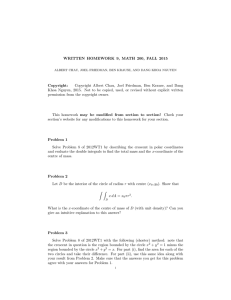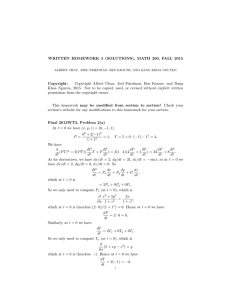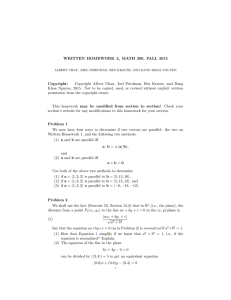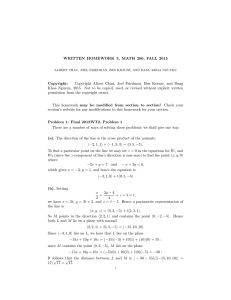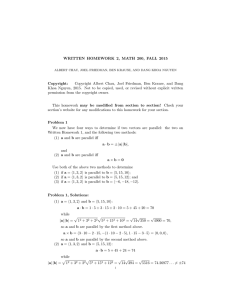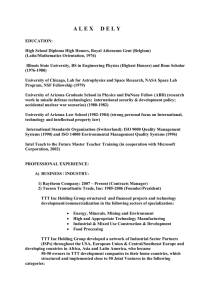WRITTEN HOMEWORK 7 (SOLUTIONS), MATH 200, FALL 2015 Copyright:
advertisement
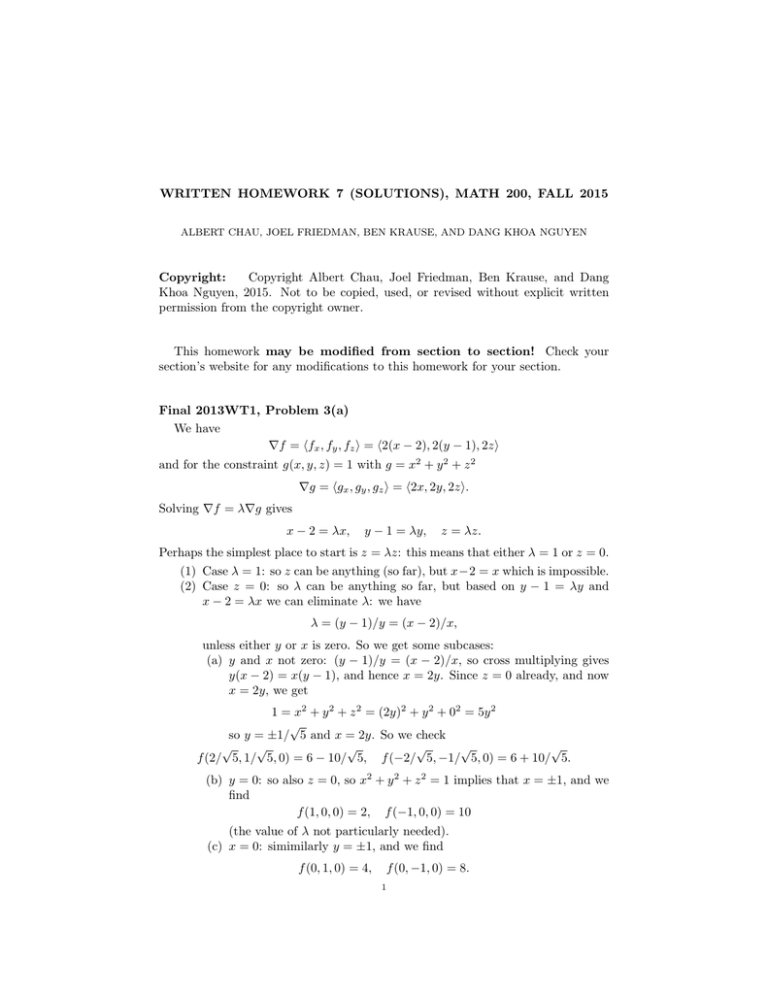
WRITTEN HOMEWORK 7 (SOLUTIONS), MATH 200, FALL 2015 ALBERT CHAU, JOEL FRIEDMAN, BEN KRAUSE, AND DANG KHOA NGUYEN Copyright: Copyright Albert Chau, Joel Friedman, Ben Krause, and Dang Khoa Nguyen, 2015. Not to be copied, used, or revised without explicit written permission from the copyright owner. This homework may be modified from section to section! Check your section’s website for any modifications to this homework for your section. Final 2013WT1, Problem 3(a) We have ∇f = hfx , fy , fz i = h2(x − 2), 2(y − 1), 2zi and for the constraint g(x, y, z) = 1 with g = x2 + y 2 + z 2 ∇g = hgx , gy , gz i = h2x, 2y, 2zi. Solving ∇f = λ∇g gives x − 2 = λx, y − 1 = λy, z = λz. Perhaps the simplest place to start is z = λz: this means that either λ = 1 or z = 0. (1) Case λ = 1: so z can be anything (so far), but x−2 = x which is impossible. (2) Case z = 0: so λ can be anything so far, but based on y − 1 = λy and x − 2 = λx we can eliminate λ: we have λ = (y − 1)/y = (x − 2)/x, unless either y or x is zero. So we get some subcases: (a) y and x not zero: (y − 1)/y = (x − 2)/x, so cross multiplying gives y(x − 2) = x(y − 1), and hence x = 2y. Since z = 0 already, and now x = 2y, we get 1 = x2 + y 2 + z 2 = (2y)2 + y 2 + 02 = 5y 2 √ so y = ±1/ 5 and x = 2y. So we check √ √ √ √ √ √ f (2/ 5, 1/ 5, 0) = 6 − 10/ 5, f (−2/ 5, −1/ 5, 0) = 6 + 10/ 5. (b) y = 0: so also z = 0, so x2 + y 2 + z 2 = 1 implies that x = ±1, and we find f (1, 0, 0) = 2, f (−1, 0, 0) = 10 (the value of λ not particularly needed). (c) x = 0: simimilarly y = ±1, and we find f (0, 1, 0) = 4, f (0, −1, 0) = 8. 1 2 ALBERT CHAU, JOEL FRIEDMAN, BEN KRAUSE, AND DANG KHOA NGUYEN So the min of f on g = 1 is the smallest and largest from among the values √ 6 ± 10/ 5, 2, 10, 4, 8, √ namely 6 − 10/ 5. Final 2013WT1, Problem 4(b) With notation as above, we have f (x, y, z) = (x2 + y 2 + z 2 + 5) − 4x − 2y. Since the constraint reads z 2 = 1 − x2 + y 2 , we can write that x2 + y 2 + z 2 = 1 implies f (x, y, z) = 6 − 4x − 2y. But this expression 6 − 4x − 2y does not involve z; the only constraint on x and y is that for some z we have x2 + y 2 + z 2 = 1, and this means that x2 + y 2 ≤ 1. So Problem 3(a) is equivalent to minimizing h(x, y) = 6 − 4x − 2y on the region x2 + y 2 = 1. Final 2012WT1, Problem 6(i) Here we have ∇f = hfx , fy , fz i = h2(x − 2), 2(y + 2), 2(z − 4)i and for the constraint g(x, y, z) = 6 with g = x2 + y 2 + z 2 ∇g = hgx , gy , gz i = h2x, 2y, 2zi. Solving ∇f = λ∇g gives x − 2 = λx, y + 2 = λy, z − 4 = λz. This means that x−2 y+2 z−4 = = x y z provided that x, y, z are all non-zero. So we get the following two cases: x, y, z are all non-zero, or at least one of x, y, z is zero. (1) In case x, y, z are all non-zero: then x−2 y+2 z−4 = = , x y z an in particular x−2 y+2 = so (x − 2)y = (y + 2)x x y so −2y = 2x or x = −y; also y+2 z−4 = so (y + 2)z = (z − 4)y y z so 2z = −4y so z = −2y. So we get x = −y and z = −2y and we solve λ= 6 = x2 + y 2 + z 2 = (−y)2 + y 2 + (−2y)2 = 6y 2 , so y = ±1, hx, y, zi = ±h−1, 1, −2i and we check f (−1, 1, −2) = (−1 − 2)2 + (1 + 2)2 + (−2 − 4)2 = 9 + 9 + 36 = 54, WRITTEN HOMEWORK 7 (SOLUTIONS), MATH 200, FALL 2015 3 and f (1, −1, 2) = (1 − 2)2 + (−1 + 2)2 + (2 − 4)2 = 1 + 1 + 4 = 6. (2) In case at least one of x, y, z is zero: lets say x = 0. Then we have x − 2 = λx = 0, so x − 2 = 0, which is impossible. Similarly y = 0 and z = 0 are impossible. Hence the min of f subject to g = 6 is 6, and its max is 54. Final 2012WT1, Problem 6(ii) The point that is farthest from (2, −2, 4) is just the point that maximizes (x − 2)2 + (y + 2)2 + (z − 4)2 . But this just happens to be the function f in Problem 6(i). So we already know that this function is maximized at h−1, 1, −2i. Department of Mathematics, University of British Columbia, Vancouver, BC V6T 1Z2, CANADA. Department of Computer Science, University of British Columbia, Vancouver, BC V6T 1Z4, CANADA, and Department of Mathematics, University of British Columbia, Vancouver, BC V6T 1Z2, CANADA. E-mail address: jf@cs.ubc.ca or jf@math.ubc.ca URL: http://www.math.ubc.ca/~jf Department of Mathematics, University of British Columbia, Vancouver, BC V6T 1Z2, CANADA. Department of Mathematics, University of British Columbia, Vancouver, BC V6T 1Z2, CANADA.
